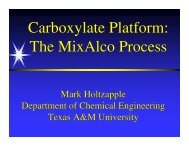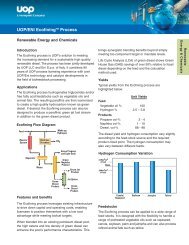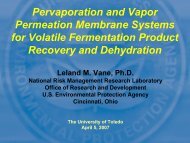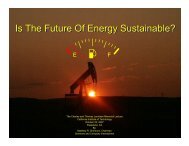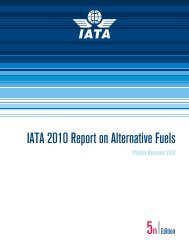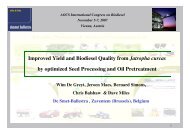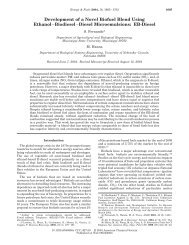OPEN PONDS AND CLOSED PHOTOBIOREACTORS ... - planktoleum
OPEN PONDS AND CLOSED PHOTOBIOREACTORS ... - planktoleum
OPEN PONDS AND CLOSED PHOTOBIOREACTORS ... - planktoleum
- No tags were found...
You also want an ePaper? Increase the reach of your titles
YUMPU automatically turns print PDFs into web optimized ePapers that Google loves.
5 th Annual World Congress on IndustrialBiotechnology & Bioprocessing, April 30, 2008 Chicago<strong>OPEN</strong> <strong>PONDS</strong> <strong>AND</strong> <strong>CLOSED</strong><strong>PHOTOBIOREACTORS</strong> –COMPARATIVE ECONOMICSJohn R. BenemannBenemann Associates, andManager, International Network on Biofixationof CO2 and Greenhouse Gas Abatement,jbenemann@aol.com1J. Benemann, 5 th Annual World Congress on Industrial Biotechnology, Chicago, April 30, 2008
Summary: The ‘Pros’ of Microalgae BiofuelsPromises: Very high productivity biomass and oil, low costsNon-compete for land, water with food productionUse CO2 from power plants and other sourcesVery large potential projected in U.S. and worldProcesses: Currently no commercial algae biofuels production.Commercial microalgae produced only for high value(>$10/kg)food supplements (>98% in open ponds)Wastewater treatment ponds, limited by harvestingProducts: Near-term: co-produce biofuels in wastewater treatmentMedium-term: co-produce with higher value animal feedsLong-term: biofuels only or with commodity animal feedsProblems: Undeveloped technology, high costs (even for ponds)Many start-ups, companies, academics now in "space“Most 90%+ using closed photobioreactors (PBRs)Many, many claims being made, Caveat emptorJ. Benemann, 3rdAnnual Renewable Energy Finance and Investment Summit, Scottsdale, AZ, May 20, 20082
Little bubbles arehydrogen gas!(my introductionto microalgaein 1973)J. Benemann, 5 th Annual World Congress on Industrial Biotechnology, Chicago, April 30, 20083
“Microalgae biotech could be a huge source of H 2 fuel”Jae Edmonds, PNNL at World Industrial Biotech Congress, 2004FUTURE SOURCES400Example of rampant extrapolation:OF HYDROGENfrom tiny bubbles to Exajoules,350from lab flasks to large scale PBRs,from
Napa, CA, Wastewater Treatment Ponds ~ 300 acmy first view of large-scale microalgae cultivation, forwastewater treatment (top ponds are for salt evaporation)me in 1974J. Benemann, 5 th Annual World Congress on Industrial Biotechnology, Chicago, April 30, 20085
Why Microalgae Biofuels? Global Warming!International Network on Biofixation of CO2and Greenhouse Gas Abatement (2002-2007)Blaine Metting, Chair; John Benemann, ManagerNIWA, NZCGTEE / Eletrobrás (Brazil)ONGC and TERI (India)SRI International (USA)PNNL 6(Pacific Northwest National Laboratory)J. Benemann, 5 th Annual World Congress on Industrial Biotechnology, Chicago, April 30, 2008
Why Microalgae Biofuels? PEAK OIL!(billion barrels oil/ year]Are we running out? Soon? Seems like it.J. Benemann, 5 th Annual World Congress on Industrial Biotechnology, Chicago, April 30, 20087
J. Benemann, 5 th Annual World Congress on Industrial Biotechnology, Chicago, April 30, 20089
SO WHY INTEREST IN MICROALGAE BIOFUELS?Some of the promises being made for microalgae• grow faster• are more productive• use power plant flue gas CO2• high vegetable oil content• use saline, brackish, waste waters• do not compete with food/feed crops• Low cost of production / processing• Enormous production potential10• Co-products, nutrient recycle, waste treatmentJ. Benemann, 5 th Annual World Congress on Industrial Biotechnology, Chicago, April 30, 2008
Examples of microalgae:Diatoms, green algae, cyanobacteriaNitzchiaAnabaenaChlorella11J. Benemann, 5 th Annual World Congress on Industrial Biotechnology, Chicago, April 30, 2008
MICROALGAE DIVERSITY - not all the same!• 30 000 described species (< 10% of estimated)• 11 Divisions divided into 29 classes (vs. 2/12 vascular plants]J. Benemann, 5 th Annual World Congress on Industrial Biotechnology, Chicago, April 30, 200812
SO, WHY MICROALGAE? REALITY CHECK• grow faster Not all that relevant (except for R&D)• more productive Possibly but not proven (need R&D!)• use power plant flue gas CO2 A need, not a virtue• have high oil content OK, but must be productive (R&D)• use saline, brackish, waste waters Yes, use less water• do not compete with agriculture We could eat algae!• Low cost of production / processing Not true!• Very Large production potential Many limitations• Co-products, Nutrient recycle, waste treatment YES!So, why Microalgae? Likely will not be a panacea, but dohave applications for biofuels and we must try and develop13all plausible biomass resources, including pond scum!J. Benemann, 5 th Annual World Congress on Industrial Biotechnology, Chicago, April 30, 2008
A Very Brief History of Algae Biofuelsthose who don’t learn from prior work are bound to repeat it• Microalgae were first mass cultured on rooftop at MIT with PBR inearly 1950s, first mention of algae biofuels in report of that project.• Methane from algae grown in ponds studied at U.C. Berkeley 1950s,Initial conceptual process and systems analysis published 1960. Theenergy shocks of the 1970s, CH 4 from wastewater treatment ponds• U.S. DOE-NREL Aquatic Species Program (ASP),1980-1996, >$25million, algae oil production. First issue: PBRs vs. open ponds.PBRs too costly. Main Project: Open pond pilot plant in New Mexico• Japan NEDO-RITE program for CO 2 abatement, from 1990 -2000,>$250 million. Focus: only PBRs. Achievements: total failure.• 2000 – Present. Some small projects (e.g. Biofixation Network) until2006 when explosion in R&D teams and companies entering “space”14>>100 projects/companies microalgae biofuels (Google). Most PBRsJ. Benemann, 5 th Annual World Congress on Industrial Biotechnology, Chicago, April 30, 2008
Two giants on whose shoulders we all stand in this fieldCarnegie Institute of Washington: Algae for Food ProjectJack Myers2006, Austin, TxBessel Kok1956, StanfordBurlew (ed.) Algae Culture from Laboratory to Pilot Plant, 1953J. Benemann, 5 th Annual World Congress on Industrial Biotechnology, Chicago, April 30, 200815
Inoculum TubesFirst mass culture projectPlastic bag-typephotobioreactorsRoof of MIT Building~ 195016J. Benemann, 5 th Annual World Congress on Industrial Biotechnology, Chicago, April 30, 2008
10 acre design based on MIT Rooftop pilot plantFisher (1956), A.D. Little Co. carried out an engineeringdesign-cost estimate for a 100 acre system of plastictubes estimating (2008 $) capital costs >$500,000/acreSite preparation and plastic tubes were only ~5% of total17Still one of the most detailed economic studies of PBRs!J. Benemann, 5 th Annual World Congress on Industrial Biotechnology, Chicago, April 30, 2008
An example of history repeating itself:GreenFuel Technologies Corp.Roof of MIT at Campus power plantTubular Photobioreactors “Gen1” capture85% NOx & 50% CO2, produce biodieselThen went to Arizona APS power plantGen 4? (photoshop) Small pilot plant failedJ. Benemann, 5 th Annual World Congress on Industrial Biotechnology, Chicago, April 30, 200818
Another Example: Solix Biofuels (photoshop)In Colorado proposed growing algae in bags (no experience, many claims)J. Benemann, 5 th Annual World Congress on Industrial Biotechnology, Chicago, April 30, 200819
Extreme claims abound: Valcent, TX, Vertigro SystemClaim: 100,000 gallons/acre-yr or ~25x maximumpossible! Violates 1 st Law of thermodynamics!!J. Benemann, 5 th Annual World Congress on Industrial Biotechnology, Chicago, April 30, 200820
A major problem are productivities being claimedSOLAR ENERGY CONVERSION WITH PHOTOSYNTHESISUS Southwest solar energy=2 MWhr (7.2 GJ)/m2-yr~assume 90% reaches the crop/or algae in pond~45% is PAR (photosynthetic active radiation)~ 90% photons are absorbed by PS pigments22% max PS efficiency (photonsbiomass energy)~75% loss to light saturation and photoinhibition~15% loss to respiration (growth, maintenance)Calculation (best case, year-round algae culture):•7.2 GJ x 0.9 x 0.45 x 0.9 x 0.22 x 0.25 x 0.85 = 0.12 GJ= Efficiency ~1.7% and ~20Gj/mt biomass= ~60 mt/ha-yr @~25% oil=15 mt/ha-yr~2,000 gallons oil/acre-year current technologyMaybe 2-3X with GMO strains or vertical PBRsJ. Benemann, 5 th Annual World Congress on Industrial Biotechnology, Chicago, April 30, 200821
PBRs small scale, thesefor R&D, not productionJ. Benemann, 5 th Annual World Congress on Industrial Biotechnology, Chicago, April 30, 200822
Commercial Photobioreactors in Spain (1989),~1 ha, >$1 million capitalShut down after two weeksJ. Benemann, 5 th Annual World Congress on Industrial Biotechnology, Chicago, April 30, 200823
Algatech, Co. Israel, Haematococcus pluvialisfor astaxanthin production ~1 ha, >> $1 millioncapital costs, now operating only sporadicallyJ. Benemann, 5 th Annual World Congress on Industrial Biotechnology, Chicago, April 30, 200824
Commercial Photobioreactor in Germany forChlorella, ~1 ha, >> $1 million/ha, went brokeJ. Benemann, 5 th Annual World Congress on Industrial Biotechnology, Chicago, April 30, 200825
Commercial covered greenhouse pond systemfor Spirulina production in China. Also failed.CONCLUSION on PBRs: Capital costs millions$/ha, all ventures even for high value productshave failed. PBRs not plausible for biofuels.J. Benemann, 5 th Annual World Congress on Industrial Biotechnology, Chicago, April 30, 200826
What is the alternative to high cost PBRs?“High Rate Ponds”: shallow raceway mixed ponds.Developed by Prof. Oswald, UC Berkeley early1950s. First practical application, with recirculationpump mixing, in early 1960’s at a municipalwastewater treatment plant (Concord, CA)J. Benemann, 5 th Annual World Congress on Industrial Biotechnology, Chicago, April 30, 200827
Paddle wheel mixingfor high rate pondsfirst used inGermanyin 1960’sJ. Benemann, 5 th Annual World Congress on Industrial Biotechnology, Chicago, April 30, 200828
The main microalga (>50%] produced commerciallyArthrospira platensis (Spirulina)31J. Benemann, 5 th Annual World Congress on Industrial Biotechnology, Chicago, April 30, 2008
Another example of Spirulina Production(Parry Nutraceuticals, Tamil Nadu, India )32J. Benemann, 5 th Annual World Congress on Industrial Biotechnology, Chicago, April 30, 2008
All large commercial microalgaeplants produce humannutritional supplements,Price $>10/kgJ. Benemann, 5 th Annual World Congress on Industrial Biotechnology, Chicago, April 30, 200833
Perspective of microalgae production nowEarthrise Farms LLC, in S. California, dwarfed by alfalfa fieldstotal world production of all microalgae is only ~10,000 tonsJ. Benemann, 5 th Annual World Congress on Industrial Biotechnology, Chicago, April 30, 200834
AN ACTUAL MICROALGAE BIOFUELS PILOT PLANT:The Israeli Seambiotics Co. produces algae biomass with~30% oil content using CO2 from coal power plant flue gas.Inventure Co., in Seattle, converted it to biodiesel and ethanolHOWEVER: ECONOMICS OF PROCESS STILL THE MAJOR CHALLENGE35Ami BenAmotzJ. Benemann, 5 th Annual World Congress on Industrial Biotechnology, Chicago, April 30, 2008
Production of Microalgae for FuelsConception of microalgae biodiesel production Aquatic Species Program,U.S. DOE NREL 1987. Note raceway growth and settling-harvesting ponds(Pre-photoshop)J. Benemann, 5 th Annual World Congress on Industrial Biotechnology, Chicago, April 30, 200836
Techno-economic analyses: open pond microalgaebiodiesel production (http://www.osti.gov/bridge/)Benemann, J.R., R.P. Goebel, R.P., J.C. Weissman, and D. C.Augenstein 1982. Microalgae as a source of liquid fuels.Final technical Report to U.S.DOE BERWeissman, J.C., and R.P. Goebel, 1987. Design and analysis ofmicroalgal open pond systems for the purpose of producingfuels: A subcontract report US DOE- SERIBenemann, J.R. and W.J., Oswald 1996, Systems and economicanalysis of microalgae ponds for conversion of CO2 tobiomass. Final eport. US DOE-NETLCONCLUSION: Reports do not conclude that we can now makealgae biodiesel economically, but define long-term R&D required.37CONCLUSION: System capital costs ~ $100,000/hectareJ. Benemann, 5 th Annual World Congress on Industrial Biotechnology, Chicago, April 30, 2008
Paper written in response to many claims that PBRs weresuperior to open ponds. Pointed out some problems facedby both open ponds and closed PBRs. The main issue for38PBRs was lack of scalability: maximum unit size ~100m2J. Benemann, 5 th Annual World Congress on Industrial Biotechnology, Chicago, April 30, 2008
Eni Project (Monterotondo, Italy)Compared PBRs & ponds using flue gas CO2RESULTS: same productivity, no difference!39J. Benemann, 5 th Annual World Congress on Industrial Biotechnology, Chicago, April 30, 2008
Open Ponds vs. Closed PhotobioreactorsParameter Relative advantage NoteContamination risk Ponds < PBRs Just a matter of time for eitherProductivity Ponds ~ PBRs NO substantial difference*Space required Ponds ~ PBRs A matter of productivityWater losses Ponds ~ PBRs Evaporative cooling neededCO2 losses Ponds ~ PBRs Depends on pH, alkalinity, etc.O2 Inhibition Ponds > PBRs O2 major problem in PBRsProcess Control Ponds ~ PBRs no major differences (weather)Biomass Concentration Ponds < PBRs function of depth, 2 -10 foldCapital/Operating Costs Ponds 10 x lower cost!*Productivity can be higher if PBRs are vertical or in cold conditions.CONCLUSION: Are PBRs better than ponds? Sometimes (e.g. incold climate), sometimes not. Advantages greatly overstated.40For biofuels can’t afford PBRs, except for inoculum productionJ. Benemann, 5 th Annual World Congress on Industrial Biotechnology, Chicago, April 30, 2008
NEAR-TERM GOAL: DEMONSTRATE ALGAE WASTEWATERTREATMENT AT AN OPERATING PLANT WITH HIGH RATE <strong>PONDS</strong>J. Benemann, 5 th Annual World Congress on Industrial Biotechnology, Chicago, April 30, 200841
A MAJOR CHALLENGE: HARVESTING ALGAL BIOMASS• Microalgae are microscopic - 1/1000 th of a cm! (10 um)• Standing biomass is only about 100 g/m2 dry weight• Need to harvest on average 30%/day every single day• Concentration in ponds at harvest only 400 mg/liter (dry)• Harvesting means concentrating 500 fold (for 20% solids)• First 100 fold most difficult (after that can use centrifuge)• Must cost
BIOFLOCCULATION OF MICROACTINIUMthese spontaneously forming flocs settle rapidly for lowcostharvesting, a key issue in mass culture of microalgaeJ. Benemann, 5 th Annual World Congress on Industrial Biotechnology, Chicago, April 30, 200843
J. Benemann, 5 th Annual World Congress on Industrial Biotechnology, Chicago, April 30, 200844
Micractinium Bioflocculation (electron microscope)we must learn how and why algae bioflocculate45J. Benemann, 5 th Annual World Congress on Industrial Biotechnology, Chicago, April 30, 2008
Photobioreactors vs. Ponds – a century onVelimir Khlebnikov from Took - The Futurists Drum(Moscow, 1915) “Grow edible microscopic organisms inlakes. Every lake will become a kettle of ready-made soupthat only needs to be heated. Contented people will lieabout on the shores, swimming and having dinner.“46So where will we be in 100 years?J. Benemann, 5 th Annual World Congress on Industrial Biotechnology, Chicago, April 30, 2008
ANY QUESTIONS?J. Benemann, 5 th Annual World Congress on Industrial Biotechnology, Chicago, April 30, 200847



